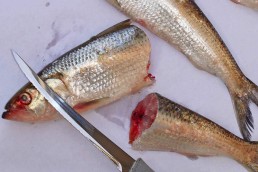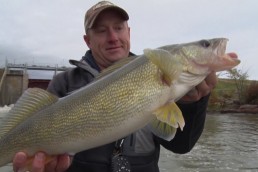‘Clamming’ for Big River Summer Catfish
SHARE THIS POST
It was an enjoyable, lazy day cat fishing the Mississippi River in southeast Iowa during the late summer, a number of years ago. In this case, the “lazy” had to do with the lack of the fish doing any work like the “tapping of a bite.” It came time to reel in my “no action” line to check if there was any bait left on the hook. As it seemed to be coming in a little slower than an empty line usually comes in, I figured I had been successful in catching one of those stick or bark fish which seems to inhabit the Big River.
As the end of the line got closer to the boat, it seemed to be doing a little wobbling back and forth. It was as if I was reeling in a huge blade bait, a little different than when it was empty or bringing in a piece of snag tree limb. As it got close to the surface, a grayish oval shell, about five or six inches in length took shape. It had picked up a ride while hitchhiking along the bottom.
I did not have to put water in my live well, because in this case my hitchhiker was a clam, or properly called a mussel, which had logged on to my hook as it was doing its eating type of thing. In this situation, I did not need to use a landing net for a flopping fish, but I was able to muscle in a member of the mucket species of freshwater mussels.
On several other trips to the Big River and a few creeks over the past couple of years, I have been surprised when reeling in a shellfish. There are many varieties found in the Big River and tributaries, along with “hooking” some zebra mussels. Of course, in the Mississippi River, muckets, which can be taken in Iowa waters, are classified as clams. There are also threatened and endangered species such as spectacle case, slippershell, buckhorn, Ozark pigtoe, bullhead, Ohio river pigtoe, Slough sandshell and yellow sand shell. The rather drab looking creatures certainly do have more colorful names.
Add in names of other protected species of mussels such as cylinder, strange floater, creek heelsplitter, purple pimpleback, butterfly, ellipse and the Higgins eye pearly mussel, and you have quite an array of different monikers to pick from. And these are real names, not just the nicknames given to fish in the same area. There is one I call mooneye, but it is also known to some anglers as slicker, toothed herring, cisco, river white fish, white shad and freshwater herring. (Why make up colorful nicknames when the clam’s names were actually given to them somewhere down the line?)
Are you enjoying this post?
You can be among the first to get the latest info on where to go, what to use and how to use it!
Since many species of clams inhabit lakes and streams, they also can be used as good bait to catch channel catfish. According to Iowa Fish And Fishing by the Iowa DNR, clams can be collected in clear water by following the trails they make in the sand or mud. Yes, they can actually propel themselves along the river bottom on the edge of a stream, although they have no visible legs or wings. From time to time, some of them are moved along the bottom by heavy current when flood stages are at hand. But their actual self-propelled movement could actually be like the storied “Peg-leg Pete-the Pirate,” as they use their one leg. According to the Missouri Conservationist website and a couple of other sources, mussels do not have a head. Instead they have a long muscular foot that protrudes from their protective house-of-shell. The mussel walks through the substrate with its foot. (I guess it could actually be called a mussel muscle and it would be true. They would really be great in the race of the tortoise and the hare.) Since they do leave a trail, a little digging down in the mud or sand at one end or the other of the trail may find the mussel “laying down on the job.” In water with less clarity, clams are located by feeling along the bottom with bare feet, originally called polly-wogging which was actually one of the ways youngsters back in the days of the pearl button industry could pick up a little money. They would collect the mussels and sell them to button operations.
Live clams may be transported easily in a wet gunnysack. If kept cool, between 60 and 70 degrees, they can be kept alive for a couple of days by simply trickling a small amount of water over them. When they are held for longer periods, they should be placed in a bait box in a stream or lake. Clam baits may be kept fresh by placing the meats in containers and freezing until ready for use, and even used in the winter for ice fishing bait in ponds or lakes that contain channel catfish.
Soured meats are generally preferred to fresh meats for catching Mr. Whiskers. Meats may be soured in a number of ways. They are cut into 3/4- to one-inch wide strips, placed in a glass jar with a little milk, and allowed to sour for three to four days at 70 to 80 degrees. Some anglers bury the jar in the ground a few inches below the surface until the meat is sour. (Not a good idea to do this process in the house, for obvious reasons.)
When ready to fish, the juices are poured off the clam meats and the clam is baited by running the hook through the toughest part of the meat. Several chunks of meat may be used at each baiting. Some folks enclose the bait in a mesh bag, such as nylon hose, or tie them on with thin thread to keep the bait on the hook. If you do handle the soured bait too much, your fingers and hands will take a few hours to get the smell off, just like it does if you used your fingers to put stink bait on a catfish worm. (On the other hand, this will help you to clear out your sinus passages if they are stuffed up!)
If you intend to use clam meat for fish bait, you need to be aware of the rules of catching and possessing clams as a licensed angler, and the rules of possessing species other than those listed as threatened or endangered in your state. You also need to be sure that zebra mussels are not taken or possessed. The angler is responsible for the identification of the mussel species in possession, since native mussels in the Mississippi River often have zebra mussels attached to them. Zebra mussels must be removed by scraping with a stiff brush before any other mussel species are transported.
MWO
SHARE THIS POST
Did you enjoy this post?
You can be among the first to get the latest info on where to go, what to use and how to use it!
MWO
We believe being outdoors is good. With more than 1,000 articles each year, MidWest Outdoors magazine is all about sharing outdoor experiences with you—where to go, what to use and how to use it… whether you’re close to home or on that trip of a lifetime.



